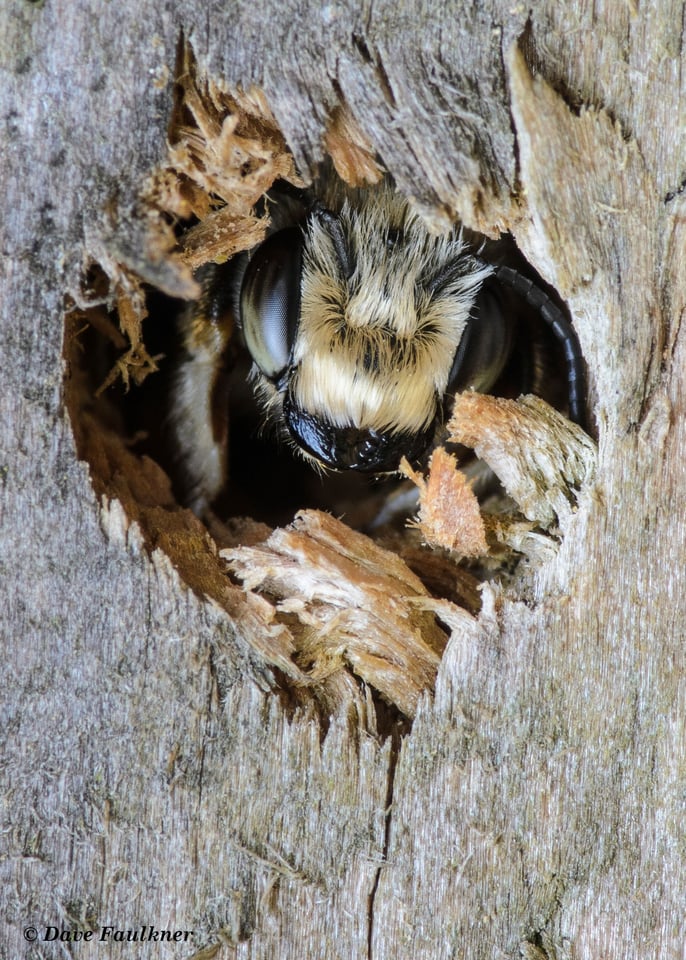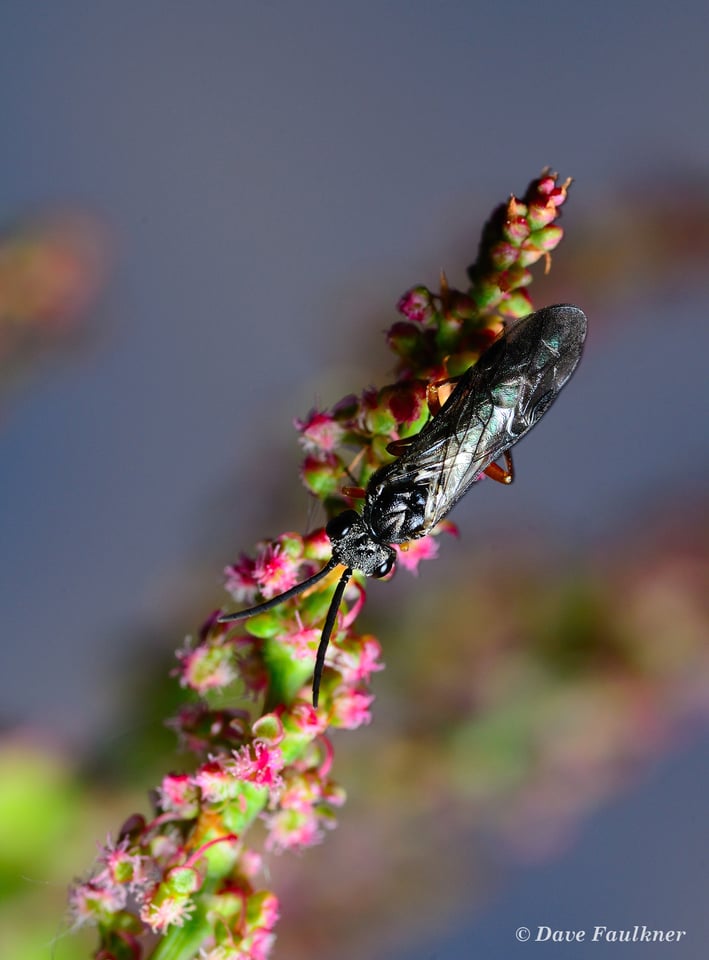I am an amateur photographer and have had a DSLR for approximately 10 years. It is only in the last 2 years that I have started to get seriously interested in wildlife photography. I feel like I am in the early days of building a portfolio of images. Living in the middle of a small UK town, like most urban locations, there is a surprising amount of wildlife around. Unfortunately, with a full time job and a small baby I found I had limited time to get to know the animals in my neighbourhood let alone the local nature spots. So when we moved house 3 years ago and were discussing what to do with the derelict patch of land out front and the idea of turning it into a wild flower garden was discussed, I thought it might be a great way to learn some macro techniques.
So I set about clearing what was a small 10 metre square patch of land, clearing it of stones and planting seed for the wild flowers. It has taken two years for the meadow to mature, but the wildlife and especially the insects have certainly moved in. The following pictures are a small selection of some the images I have taken in our front garden along with descriptions of the techniques I used to take them. I hope they give fellow beginners ideas for creating their own photographs in their gardens.
First up is a flower shot, what macro article would be complete without one. This is a Common Knapweed flower. I like doing macro work handheld if possible as it allows me to work quickly. I used an SB-800 flash mounted a tripod with a shoot through umbrella acting as a diffuser. The flash was triggered by the on-board flash on my Nikon D7000, manually set to the lowest setting so it didn’t add much light. There was a reasonable amount of ambient light so to get flower isolated on a black background I pegged the black jumper I was wearing to the hedge behind the flower. I used a Tokina 100mm macro lens at f/16 and on manual focus to get the front half of the flower in focus. Beyond f/16 the lens starts to lose sharpness due to diffraction.

Nikon D7000 + Tokina 100mm f/2.8 macro @ ISO 250, 1/60, f/16 with off camera SB800 flash
This one breaks all sorts of rules, which is one of the reasons I like it. The image is of a solitary bee holed up in the bug hotel we made to put in the flower meadow. The holes we drilled are 5mm so this is getting pretty close up. Taking the image was helped immensely by the fact the bug hotel is a solid wood construction that is probably more stable that my camera tripod. I again used the Tokina 100mm macro but this time with a Nikon TC-16A teleconverter and a Sigma +1.6 diopter achromatic close up lens. A tripod goes without saying for this much magnification but I also shot the image using a wired remote trigger and mirror lockup to minimise camera movement. To get the exposure of the bee right I used spot metering and centred the camera on his head. He was a few mm back in the hole so not lit directly by the sunlight falling on the rest of the wood.

Nikon D7000 + Tokina 100mm f/2.8 macro + Nikon TC-16A + Sigma +1.6 diopter @ ISO 250, 1/60, f/16
Everybody loves ladybirds, don’t they? A Change of tactic here as I had just started experimenting with using telephoto lenses for macro work. This was taken hand held under ambient light late in the evening. the ISO level is really pushing the D7000 here, especially the reds on the ladybird. It also stretched my Photoshop skills to get the noise down within this image.

Nikon D7000 + 70-200 f/2.8 + TC-17 E II @ 330mm, ISO 1250, 1/50, f/7.1
Another bee in this shot, this time on the same common sorrel but this time in flower. Very similar setup to the 1st flower picture, only difference being I decided not to isolate against a black backdrop giving the image a little more depth. I just about got away with using the lens at f/20.

Nikon D7000 + Tokina 100mm f/2.8 macro @ ISO 320, 1/125, f/20 with off camera SB800 flash
I saved my favourite till last, this image best represents where my skills have go me to. I am no longer content with just getting the image of a particular specimen or insect. I am now able to use my improved skills to try and strive for something a bit more creative. This image was taken on a chilly summer evening just before sunset. The cooler temperature meant this common blue damselfly didn’t fly off as I manoeuvred my lens towards him, in fact he posed just where I wanted him. Trusty Tokina lens again with the sigma close up filter, tripod and wired remote trigger.

Nikon D7000 + Tokina 100mm f/2.8 macro + Sigma +1.6 diopter @ ISO 500, 1/6, f/16
Next on my list of macro skills are focus stacking and replacing the teleconverters with extension tubes. Oh and we are planning to squeeze a pond into our tiny front garden, so fingers crossed we can attract a little more diversity in. My current passion is wildlife photography and my growing portfolio and blog can be seen at my website.
This guest post was contributed by Dave Faulkner. Please visit his website at the above URL to see more of his work.
Great shots, and excellent pointers. Thanks for taking time to explain the process behind each photograph.
Thomas Stirr’s wild life pics in Aliens Among Us are better.
All your images are interesting. I found the bee image to be compelling. Keep shootin’.
Thank you for the inspiration. You’ve done exactly what I would like to do. We have moved house and have some spare garden. I’ve bought Chris Packham’s ‘Back garden nature reserve’ for some ideas on how to get the wildlife here. I was also going to try out my 300mm/f4 on my D7100 as a nature lens (although it appears that an upgrade to the new one would come in handy with the VR ….).
Thanks Dave, enjoyed the article & images. Nice website, too. I appreciate your insight on the lens, as I shoot with a very similar camera (D7200), and don’t have a lens for macro purposes yet.
Thanks Judit,
The lens has been great for macro work, it does however extend a long way when close focussing and this can spook some of the insects I like to photograph. If you already have a 70-200 lens (or any high quality telephoto) I would recommend you give it a try, I have been having great success with a TC-17A attached for macro. It gives a lot more working distance and has allowed me to get some great images in the field.
You don’t have to use a teleconverter to get close either, extension tubes or a close up filter can work just as well.
Dave.
Hi Dave
Another display of images proofing that you don’t need giga megapixels cameras to make great images.
Outstanding images, none the run-of-the-mill, but instead each one was creative.
Nice shots.
I love the last one.
Hi Dave,
Nice article and images. I. really like the bee and ladybug shots.
I also followed the link to your website. I liked the wolf images and your review of the old 100-300 lens. It sure renders some nice colors!
Thanks again.
Thanks sceptical1
I agree colours are great with that Nikon lens, also great fun to use. I forgot how easy a push pull zoom lens can be to get great shots with.
Dave
Dave, I have been trying to get a hold of you via email, but emails come back with errors. Could you please let me know how I can send you the money for the guest post? Thanks!